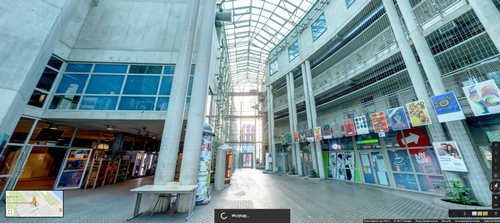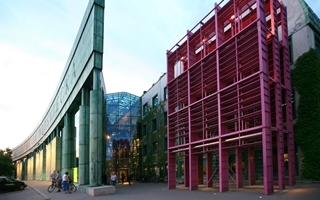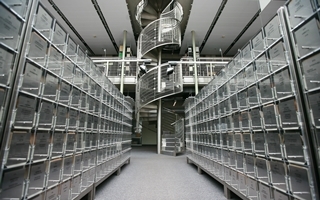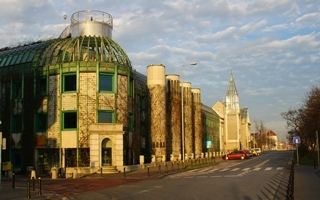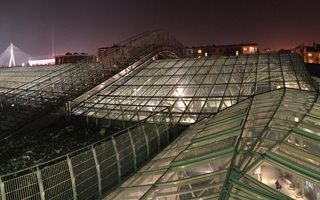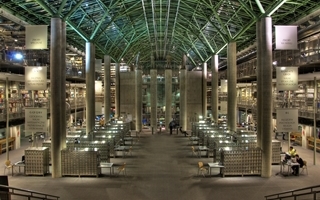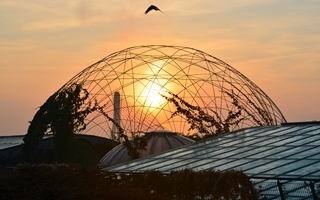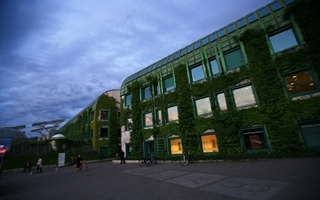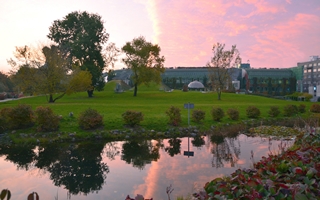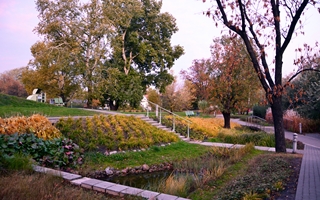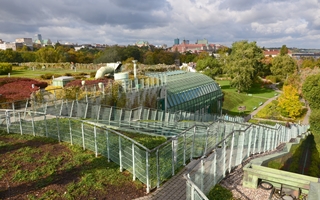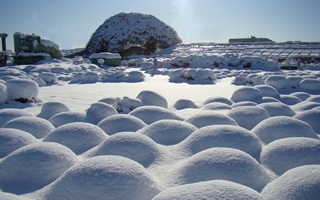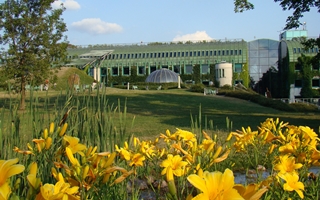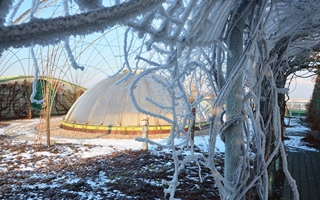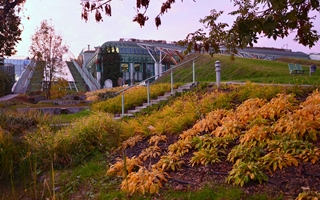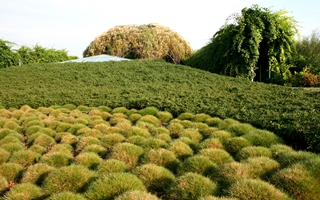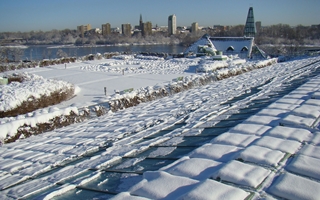Building and garden
Building
The new building of the Warsaw University Library has won numerous prestigious awards and prizes in architectural competitions and polls among residents of the capital. The concept, which combines the functionality of a modern library, respect for the shaping of the Vistula embankment, and fascination with the intermingling of culture and nature, found expression in a building of surprising diversity. The facade on the Dobra Street side was monumental in nature thanks to the installation of eight panels (4 x7 m) topped by a frieze with the inscription Biblioteka Uniwersytecka. The panels, symbolizing pages of books, present fragments of texts: the old Polish Exposition of the virtues by Jan Kochanowski, the old Russian Novels of the Past from the beginning of the 12th century, the Greek Phaedrus of Plato, the Arabic Book of Animals by Al-Jahiz, the Hebrew Book of Ezekiel, the Sanskrit Rig Veda and two notations: mathematical-physical and musical (from the Etude b-moll by Karol Szymanowski). The whole is made of patinated copper, and its green colour harmonizes with the external elements of the building – “climbing” up to the roof garden and facades, which were covered with copper networks, giving support to the creepers and panes of glass which reflect the vegetation.
In 2004, at the entrance to the building a portion of the steel structure transferred from the former warehouse building was set. This, Poland’s only example of 19th-century library grid construction, became a symbolic link between the past and the present.
The entrance to the Library from the hidden passage, called the “Passage”, is crowned by the BUW symbol: an open book of patinated bronze with the inscription Hinc Omnia (hence all). At the top of the stairs leading to the catalogue hall on level 1 rise four columns of concrete with sculptures by Adam Myjak, representing eminent Polish philosophers of the Lvov-Warsaw School: Kazimierz Twardowski, Jan Łukasiewicz, Alfred Tarski, and Stanislaw Leśniewski; the inscriptions adorning the columns contain extracts of texts from their works.
A special place is the Chashitsu Kaian – a traditional Japanese tea pavilion, donated in 2004 by the Kyoei Steel company to the Department of Japanese and Korean Studies of the Faculty of Oriental Studies, University of Warsaw, and placed on the Library’s 2nd level. Designed by Teruhito Iijima, the pavilion and its surroundings were built from natural materials (wood, bamboo, paper, clay, stone), becoming an example, rare outside of Japan, of the traditional architecture of that country. University classes are held there devoted to Japanese culture, the tea ceremony, presentations, and open chanoyu workshops.
Garden
Opening hours:
- 8.00 – 20.00 – from May 1st – until September 30th
- 8.00 – 18.00 – April and October
- 8.00 – 15.00 – from November 1st – March 31st – only the Lower Garden
The garden on the roof of the University of Warsaw Library is one of the largest and most beautiful roof gardens in Europe. It is a very popular resting place for students, residents of Warsaw, and tourists. It is used by the organizers of concerts and happenings, summer cinema, and urban games. The garden consists of two parts: the upper (2000 m2) and lower (15,000 m2), where the main attractions are the ponds, the fountain, and the granite sculptures by Ryszard Stryjecki from the series Szkic sytuacyjny, referring to cosmological motifs.
From the roof, visitors can admire the city skyline and views of the Vistula River, and an abundance of plants planted by dominant colour. Gold is composed of yellow and orange flowering shrubs, including forsythia and vines, silver has silver-leaved willows, white with blooming Dasiphora fruticosa, as well as dwarf pine, Norwegian Spirea, creeping cotoneaster and juniper. The colour carmine is represented by pink and red flowering shrubs: Weigela florida, Meyer lilac, Clematis alpine, and cotoneaster. In the summer ground cover Super Dorothy roses bloom. The compostion is framed by miniature apple trees. The Garden on the Dobra Street side is slowly becoming blue. Its pride is the perennial clematis: Creeping Arabella, which blooms from June to September, and the beautifully fragrant clematis Cassandra; creeping cotoneaster complements these. Entrance to the roof from the garden, the “ramp” is occupied by blue blooming and evergreen periwinkle. The gazebo rising over the skylight is entwined with the five-leaf Virginia Creeper Trakai. This very hardy variety found in Lithuania fades to purple in autumn. The garden areas are connected by walkways, path, bridges and pergolas, on which Zilga vines, climbing hydrangea, and clematis grow.
BUW garden regulations
- Garden Do’s:
- Only pedestrian traffic is allowed, in the upper garden only along the designated paths;
- children under 16 must be accompanied by parents or carers.
- Garden Don’ts: In the garden it is forbidden to:
- damage or pluck plants;
- damage or move any infrastructure elements;
- tamper with any technical appliances;
- touch any glass surfaces of the building;
- stay on the roof during storms and strong winds;
- lean out of the railings on the roof;
- swing the viewing platform;
- throw any objects from the roof;
- step into water or climb trees;
- disturb silence or public order;
- bring and drink alcohol or use any other illegal substances;
- run any commercial activity or peddle;
- bring any animals (excluding guide dogs);
- create fire hazards.
- The following activities require a written consent of the BUW Director or the Administrator of the BUW complex:
- holding public events and gatherings;
- organizing money collections;
- running any commercial activity or peddling;
- placing adverts or posters;
- commercial photographing or filming with the provision that photographs intended for publication must bear the name of the garden;
- staying in the garden outside the sightseeing times;
- providing the garden for scientific and research purposes.
- Final provisions:
- in the garden you must follow the instructions of the security staff and the Administrator of the BUW complex resulting from these Regulations;
- the owner of the garden and the Administrator of the BUW complex are not responsible for any accidents that occurred due to non-compliance with applicable law and the provisions of these Regulations, including accidents caused by third parties;
- the owner of the garden and the Administrator of the BUW complex do not provide protection for people staying in the garden and property brought into the garden;
- visitors and those using the garden facilities bear full responsibility for damage caused by them or persons in their care;
- controlling and enforcing the provisions of the regulations are the responsibility of the security staff and the Administrator of the BUW complex;
- persons violating the provisions of these Regulations may be subject to criminal liability whose mode and principles have been determined, among other things, in:
- the Act of 20 May 1971, the Misdemeanor Code (consolidated text, Journal of Laws of 2013, item 482);
- the Act of 26 October 1982 on Upbringing in Sobriety and Counteracting Alcoholism (Journal of Laws of 1982, no. 35, item 230);
- the Act of 31 January 1980, on the Protection and Shaping of the Environment (Journal of Laws of 1980, no. 3, item 6);
- the Act of 16 April 2004 on Nature Conservation (Journal of Laws of 2004, No. 92, item 880);
- Any complaints and requests related to the functioning of the garden shall be made to:
the Administrator of BUW complex – the Office of Real Estate “Powiśle” 00-312 Warsaw, ul. Dobra 68/70 or by email to: bnp@adm.uw.edu.pl. Office opening times: Monday – Friday 8.00 – 16.00, phone 22 55 25 918






